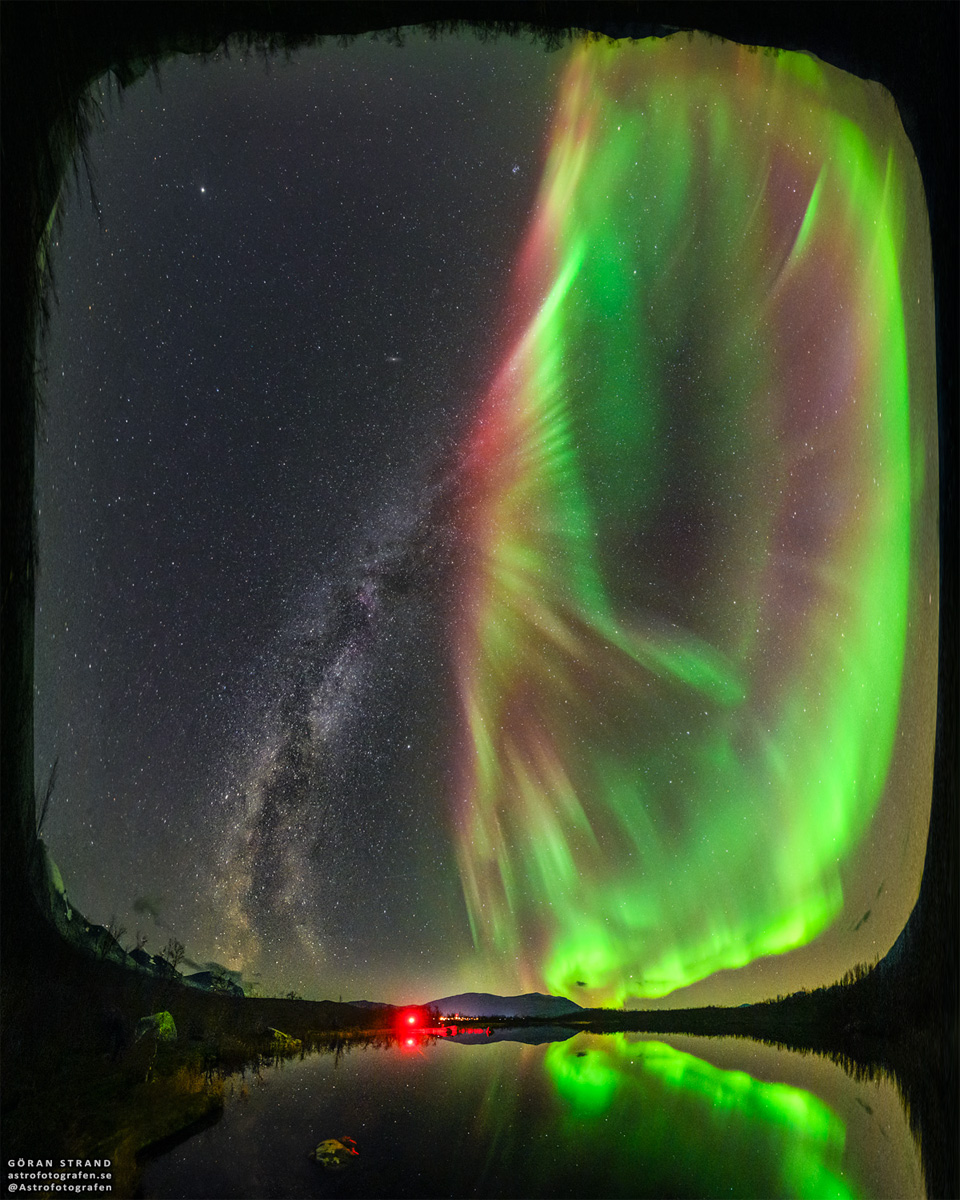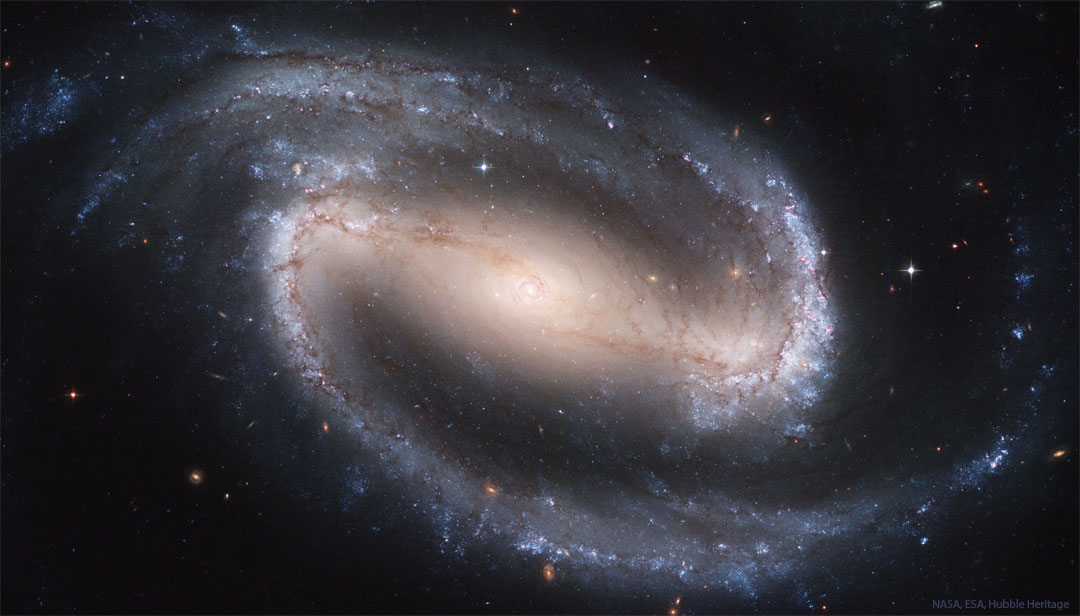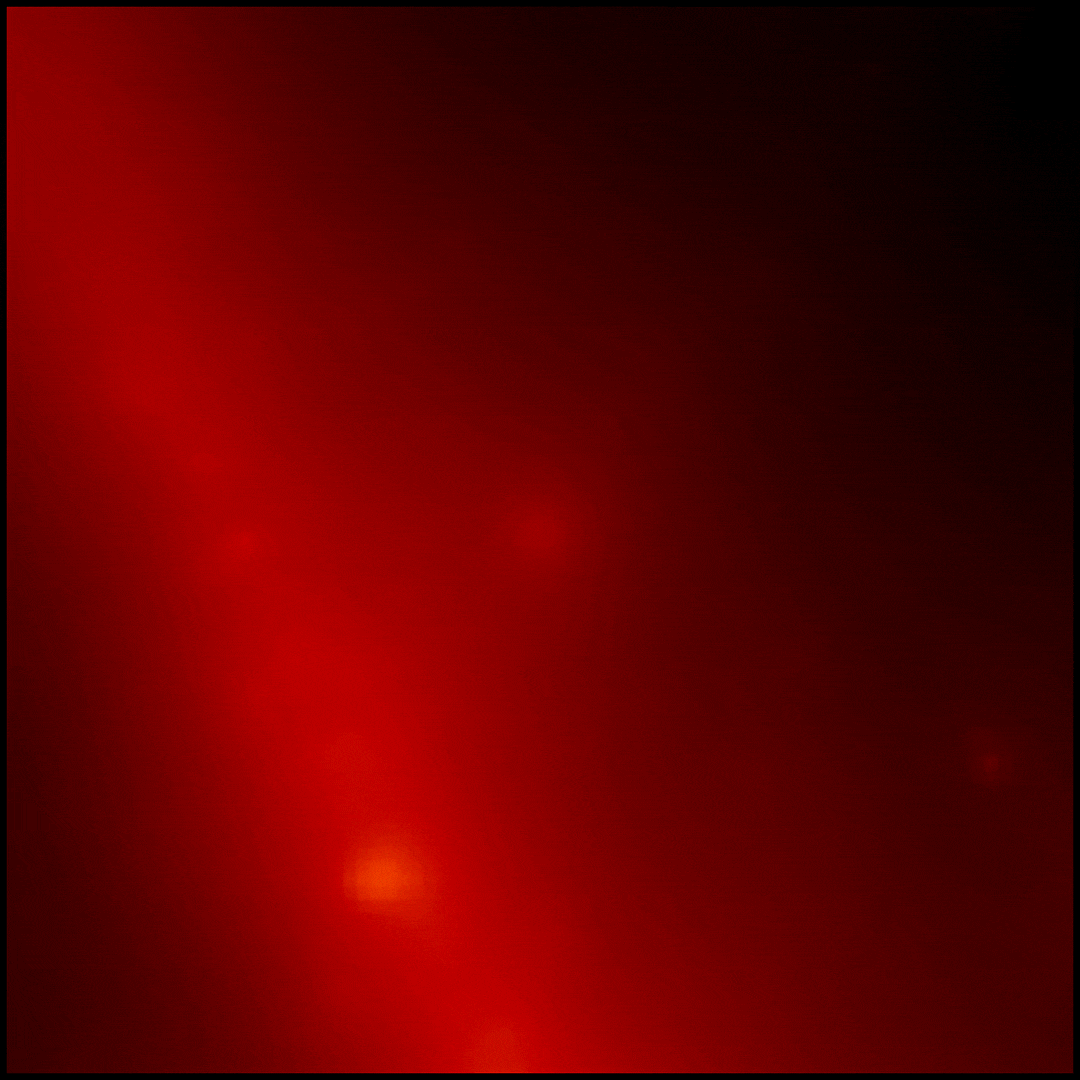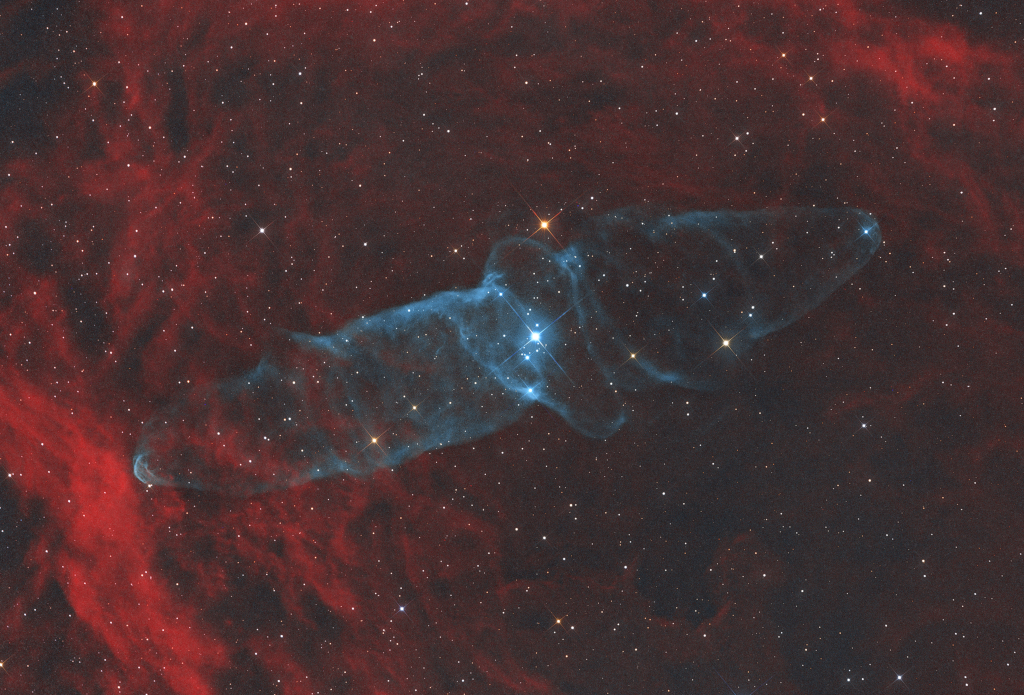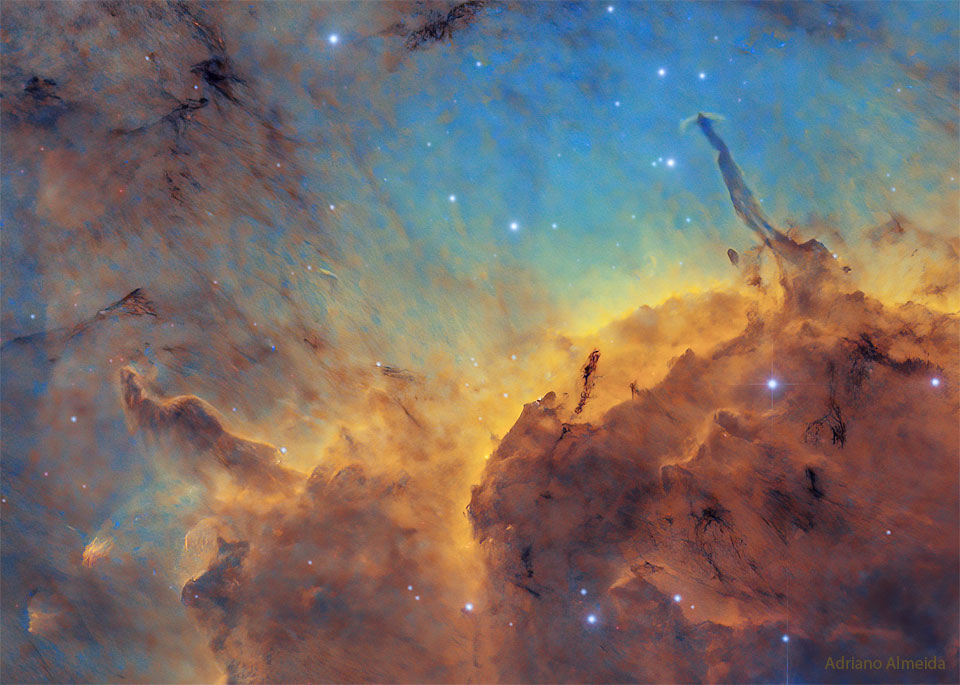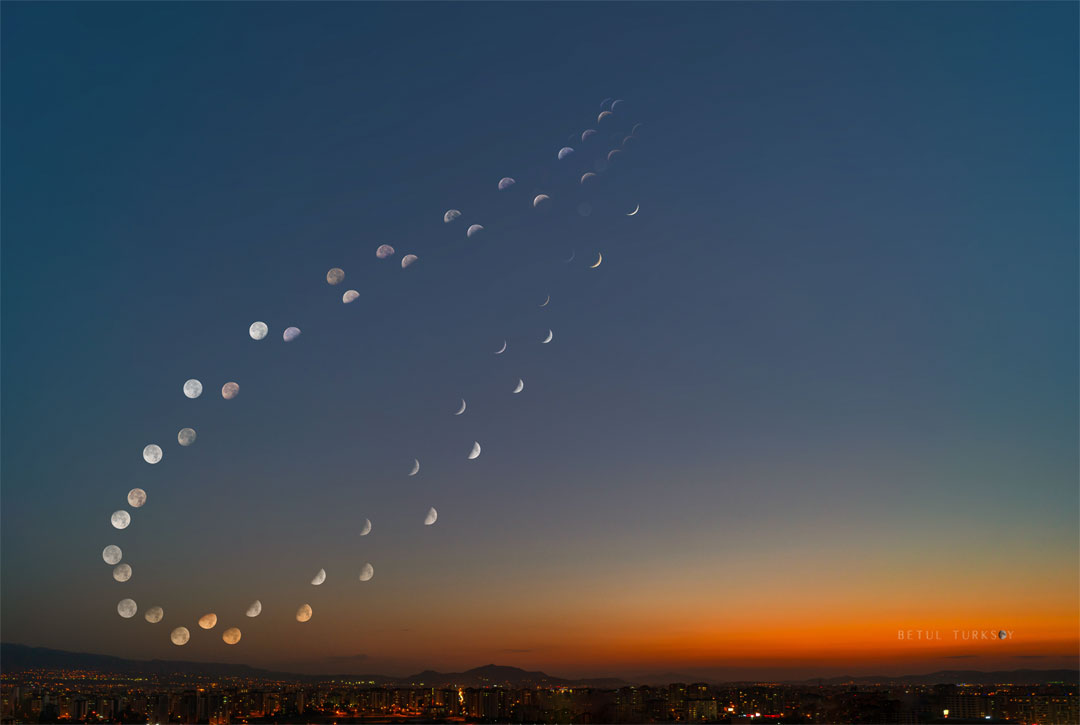Nombre total de pages vues
18/10/2022
AVIATION IMAGINEE - Des ballons gonflables pour marcher sur l'eau
ASTRONOMY - Milky Way Auroral Flower
2022 October 18
Image Credit & Copyright: Göran Strand
Explanation: Could the stem of our Milky Way bloom into an auroral flower? No, not really, even though it may appear that way in today’s featured all-sky image. On the left, the central plane of our home galaxy extends from the horizon past the middle of the sky. On the right, an auroral oval also extends from the sky's center -- but is dominated by bright green-glowing oxygen. The two are not physically connected, because the aurora is relatively nearby, with the higher red parts occurring in Earth's atmosphere only about 1000 kilometers high. In contrast, an average distance to the stars and nebulas we see in the Milky Way more like 1000 light-years away - 10 trillion times further. The featured image composite was taken in early October across a small lake in Abisko, northern Sweden. As our Sun's magnetic field evolves into the active part of its 11-year cycle, auroras near both of Earth's poles are sure to become more frequent.
17/10/2022
MACROPHOTOGRAPHIE - Miki Asai -Lorsque deux mondes se rejoignent
16/10/2022
ASTRONOMY - Barred Spiral Galaxy NGC 1300
2022 October 16
Image Credit: NASA ESA, Hubble Heritage
Explanation: Across the center of this spiral galaxy is a bar. And at the center of this bar is smaller spiral. And at the center of that spiral is a supermassive black hole. This all happens in the big, beautiful, barred spiral galaxy cataloged as NGC 1300, a galaxy that lies some 70 million light-years away toward the constellation of the river Eridanus. This Hubble Space Telescope composite view of the gorgeous island universe is one of the most detailed Hubble images ever made of a complete galaxy. NGC 1300 spans over 100,000 light-years and the Hubble image reveals striking details of the galaxy's dominant central bar and majestic spiral arms. How the giant bar formed, how it remains, and how it affects star formation remains an active topic of research.
15/10/2022
ASTRONOMY - GRB 221009A
2022 October 15
Image Credit: NASA, DOE, Fermi LAT Collaboration
Explanation: Gamma-ray burst GRB 221009A likely signals the birth of a new black hole, formed at the core of a collapsing star long ago in the distant universe. The extremely powerful blast is depicted in this animated gif constructed using data from the Fermi Gamma Ray Space Telescope. Fermi captured the data at gamma-ray energies, detecting photons with over 100 million electron volts. In comparison visible light photons have energies of about 2 electron volts. A steady, high energy gamma-ray glow from the plane of our Milky Way galaxy runs diagonally through the 20 degree wide frame at the left, while the transient gamma-ray flash from GRB 221009A appears at center and then fades. One of the brightest gamma-ray bursts ever detected GRB 221009A is also close as far as gamma-ray bursts go, but still lies about 2 billion light-years away. In low Earth orbit Fermi’s Large Area Telescope recorded gamma-ray photons from the burst for more than 10 hours as high-energy radiation from GRB 221009A swept over planet Earth last Sunday, October 9.
13/10/2022
ASTRONOMY - Dust Shells around WR 140 from Webb
2022 October 13
Image Credit: NASA, ESA, CSA, JWST, MIRI, ERS Program 1349; Processing: Judy Schmidt
Explanation: What are those strange rings? Rich in dust, the rings are likely 3D shells -- but how they were created remains a topic of research. Where they were created is well known: in a binary star system that lies about 6,000 light years away toward the constellation of the Swan (Cygnus) -- a system dominated by the Wolf-Rayet star WR 140. Wolf-Rayet stars are massive, bright, and known for their tumultuous winds. They are also known for creating and dispersing heavy elements such as carbon which is a building block of interstellar dust. The other star in the binary is also bright and massive -- but not as active. The two great stars joust in an oblong orbit as they approach each other about every eight years. When at closest approach, the X-ray emission from the system increases, as, apparently, does the dust expelled into space -- creating another shell. The featured infrared image by the new Webb Space Telescope resolves greater details and more dust shells than ever before.
AVIATION IMAGINEE - La montgolfière familiale
12/10/2022
ASTRONOMY - Ou4: The Giant Squid Nebula
2022 October 12
Image Credit & Copyright: Tommy Lease
Explanation: A mysterious squid-like cosmic cloud, this nebula is very faint, but also very large in planet Earth's sky. In the image, composed with 30 hours of narrowband image data, it spans nearly three full moons toward the royal constellation Cepheus. Discovered in 2011 by French astro-imager Nicolas Outters, the Squid Nebula's bipolar shape is distinguished here by the telltale blue-green emission from doubly ionized oxygen atoms. Though apparently surrounded by the reddish hydrogen emission region Sh2-129, the true distance and nature of the Squid Nebula have been difficult to determine. Still, a more recent investigation suggests Ou4 really does lie within Sh2-129 some 2,300 light-years away. Consistent with that scenario, the cosmic squid would represent a spectacular outflow of material driven by a triple system of hot, massive stars, cataloged as HR8119, seen near the center of the nebula. If so, this truly giant squid nebula would physically be over 50 light-years across.
11/10/2022
ASTRONOMY - Stars, Dust, Pillars, and Jets in the Pelican Nebula
2022 October 11
Image Credit & Copyright: Adriano Almeida
Explanation: What dark structures arise within the Pelican Nebula? On the whole, the nebula appears like a bird (a pelican) and is seen toward the constellation of a different bird: Cygnus, a Swan. But inside, the Pelican Nebula is a place lit up by new stars and befouled by dark dust. Smoke-sized dust grains start as simple carbon compounds formed in the cool atmospheres of young stars but are dispersed by stellar winds and explosions. Two impressive Herbig-Haro jets are seen emitted by the star HH 555 on the right, and these jets are helping to destroy the light year-long dust pillar that contains it. Other pillars and jets are also visible. The featured image was scientifically-colored to emphasize light emitted by small amounts of heavy elements in a nebula made predominantly of the light elements hydrogen and helium. The Pelican Nebula (IC 5067 and IC 5070) is about 2,000 light-years away and can be found with a small telescope to the northeast of the bright star Deneb.
10/10/2022
ASTRONOMY - A Double Lunar Analemma over Turkey
2022 October 10
Image Credit & Copyright: Betul Turksoy
Explanation: An analemma is that figure-8 curve you get when you mark the position of the Sun at the same time each day for one year. But the trick to imaging an analemma of the Moon is to wait bit longer. On average the Moon returns to the same position in the sky about 50 minutes and 29 seconds later each day. So photograph the Moon 50 minutes 29 seconds later on successive days. Over one lunation or lunar month it will trace out an analemma-like curve as the Moon's actual position wanders due to its tilted and elliptical orbit. Since the featured image was taken over two months, it actually shows a double lunar analemma. Crescent lunar phases too thin and faint to capture around the New moon are missing. The two months the persistent astrophotographer chose were during a good stretch of weather during July and August, and the location was Kayseri, Turkey
SANTé/MéDECINE - CANCER - 12 AVANCéES REVOLUTIONNAIRES - 2. Un test sanguin capable de détecter 18 cancers dès le stade précoce
Des chercheurs américains ont mis au point un test sanguin révolutionnaire capable d’identifier 18 types de cancer à un stade précoce, en an...

-
2022 September 26 All the Water on Planet Earth Illustration Credit: Jack Cook, Adam Nieman, Woods Hole Oceanographic Institution ; Data ...
-
2025 May 11 The Surface of Venus from Venera 14 Image Credit: Soviet Planetary Exploration Program , Venera 14 ; Processing & Copyri...

